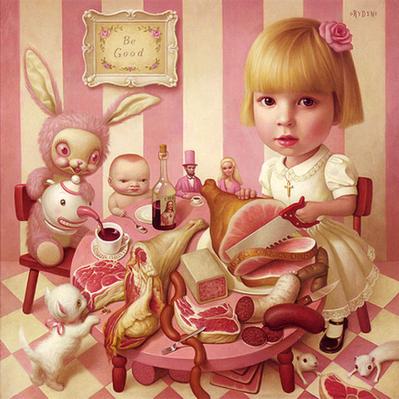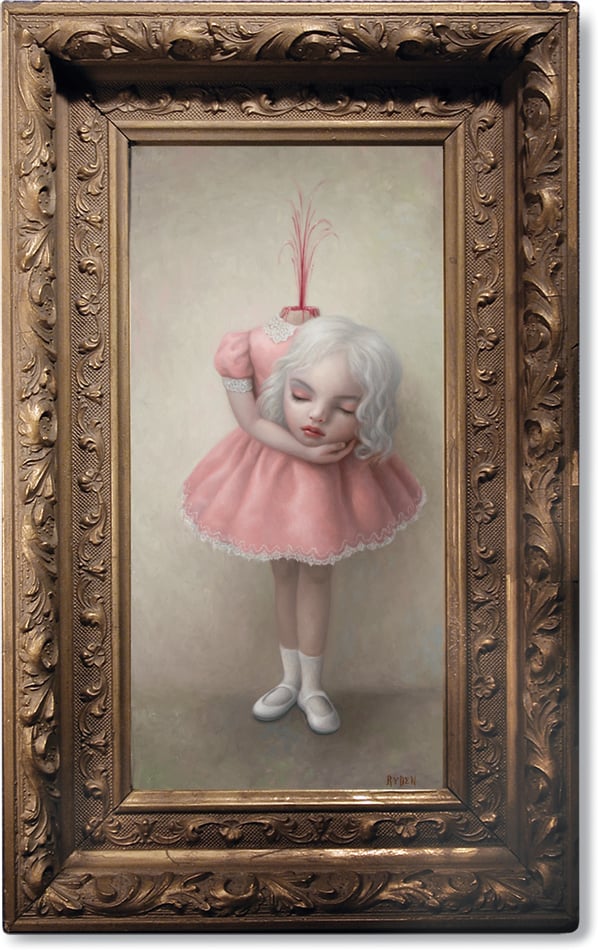Opinion
Catholic League Targets Museum Over Mark Ryden’s ‘Anti-Christian’ Art
A museum is threatened with losing public funding.

A museum is threatened with losing public funding.

It’s a tempest in a tea party. Specifically, it’s a crusade over a painting of a tea party, and one that involves threats to revoke a museum’s public funding, in the latest battle in the decades-long American culture wars.
The outrage this time around is inspired by Rosie’s Tea Party, a 2003 painting by the self-professed “pop surrealist” artist Mark Ryden, included in a show opening Saturday at the Museum of Contemporary Art in Virginia Beach. “Turn the Page: The First 10 Years of Hi-Fructose Magazine” surveys the work of 51 artists who appeared in the widely read San Francisco quarterly, dedicated to so-called “lowbrow” art.
Benito Loyola, CEO of local IT company Loyola Enterprises, is a member of the Virginia Beach Arts and Humanities Commission, and he isn’t happy. He’s taken issue with two of the Ryden paintings in the show, one of which features an offbeat, satirical take on Catholic ritual.
Loyola has even threatened to slash the museum’s funding for promoting “anti-Christian bigotry.” As it happens, a meeting about funding for the institution for the coming year is set to happen in the coming weeks. The museum, with an annual operating budget in the neighborhood of $2 million, gets $120,000 a year from the commission.
Local media has gotten in on the story, and the kerfuffle has now attracted the attention of hard-right Catholic League head Bill Donohue, who issued a letter targeting museum director Debi Gray.
Donohue is a prominent player in a long line of bruising anti-art outrages, from the 1997 Brooklyn Museum protest over Chris Ofili’s The Holy Virgin Mary, which includes elephant dung, to the 2010 attack on the Smithsonian for showing David Wojnarowicz’s video A Fire In My Belly, which includes a few seconds showing ants crawling on a crucifix. (Then-New York Mayor Rudolph Giuliani failed in his crusade against the Brooklyn Museum; the Smithsonian suffered a black eye when its director peremptorily removed Wojnarowicz’s video from an exhibition. )
Drumming up a sense of grievance over art offenses, it seems, is still good business.
Yesterday, Svetlana Mintcheva, head of programs at the National Coalition Against Censorship (NCAC), fired back with an open letter to Loyola and his fellow-commissioner Brian Kirwin, who has also spoken out against funding the museum. It reads, in part:
While totalitarian and undemocratic societies have suppressed art and demonized artists, burned heretics and tortured dissenters, I hope you will agree that we are fortunate to be living in a country where the use of religious symbols in art, whether approved by church dogma or not, is protected under the First Amendment. The government cannot suppress real or imagined attacks upon a particular religious doctrine, nor can it suppress works of art said to be “offensive, sacrilegious, morally improper or dangerous.” Contrary to what you appear to believe, government officials are also barred from using the power of the purse to discriminate against art based on the viewpoint expressed in it.
As for the contested artwork, Rosie’s Tea Party is not exactly Piss Christ, Andres Serrano‘s notorious photograph of a crucifix immersed in urine, or even Ofili’s woefully misunderstood The Holy Virgin Mary. Ryden generally trades in saccharine cuteness, cut with intentionally outrageous riffs on historical figures and pop-culture icons. One of the paintings in question features an angelic, doe-eyed girl sharing a meal with a slightly crazed-looking stuffed animal.
“Look at this—she’s got a saw in her hand cutting off a piece of ham with the words on the ham ‘Corpus Christ,’” Loyola told local news station WAVY, unpacking just what it was about the painting’s colorful iconography that so enraged him. “That is Latin for ‘body of Christ,’ and the ham is dropping down and eaten by rats.”
He also took issue with another Ryden painting, this one featuring another little girl, holding her own decapitated head in her arm as a cartoonish spurt of blood blossoms from her neck.

Mark Ryden, Fountain (2003). Image: Courtesy Mark Ryden.
“She is holding the severed head, and blood is spraying up and showering her in blood,” Loyola told WAVY. “I’m like, ‘This is what we are subsidizing at MOCA?’” (Loyola might be interested to learn that there is a rather long history of gory depictions of decapitation in Christian art.)
More than the rather cryptic imagery, what really cemented the interpretation of Ryden’s work as “anti-Christian bigotry,” it seems, is a 2006 Hi-Fructose interview with the artist in which he declares, “Someone ought to poke fun at those Christians, though.”
That line has been circulating widely in stories about the dust-up. Few commentators—including the reporters at WAVY, who have probably done most to amplify this story—cite the line that follows the offending sentence. The full Ryden quote is as follows:
I am really not poking fun at religion. I am just looking at it in different ways. Someone ought to poke fun at those Christians, though. They are the ones responsible for putting that evil clown in the White House.
That is, Ryden was making a (rather clumsy) political point, about then-president George W. Bush, who supposedly declared that God instructed him to invade Iraq.
As for Rosie’s Tea Party, all Ryden says about it in the incriminating interview is that it is a portrait of his own daughter, and that she enjoyed posing for it.
More germane to the current affair might be another passage. Asked whether people impose their own interpretations of his works, Ryden says,
There are many symbolic meanings in my art that I myself am not necessarily conscious of. The most powerful meanings in art come from another source outside an artist’s own literal consciousness. To me, tapping into this world is the key to the making the most interesting art. Some people find my refusal to explain everything in my work deeply dissatisfying. They can’t stand mystery. They need to literalize it all and tie it up in a neat little package.
Or, in this case, an ugly little package.
Turn the Page: The First Ten Years of Hi-Fructose opens May 21st at the Virginia Museum of Contemporary Art (MOCA), and remains on view through December 31, 2016; it travels to the Akron Art Museum, Ohio (February 10, 2017-May 7, 2017) and the Crocker Art Museum, Sacramento, California, June 11, 2017-September 17, 2017.